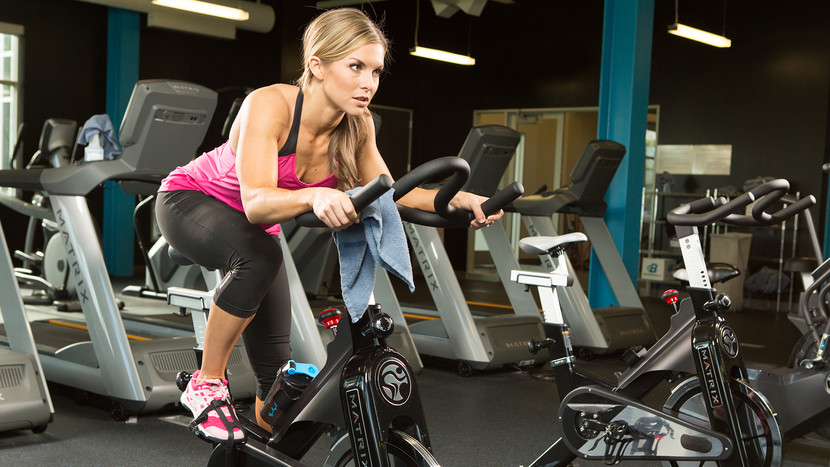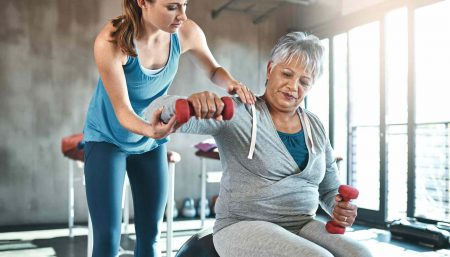High-intensity interval training (HIIT), also called High-Intensity Intermittent Exercise (HIIE) or sprint interval training (SIT), is an enhanced form of interval training, an exercise strategy alternating periods of short intense anaerobic exercise with less-intense recovery periods. HIIT is a form of cardiovascular exercise. Usual HIIT sessions may vary from 4–30 minutes. These short, intense workouts provide improved athletic capacity and condition, improved glucose metabolism, and improved fat burning.

Procedure of High-intensity interval training
A HIIT session often consists of a warm up period of exercise, followed by three to ten repetitions of high intensity exercise, separated by medium intensity exercise for recovery, and ending with a period of cool down exercise. The high intensity exercise should be done at near maximum intensity. The medium exercise should be about 50% intensity. The number of repetitions and length of each depends on the exercise, but may be as little as three repetitions with just 20 seconds of intense exercise.
There is no specific formula to HIIT. Depending on one’s level of cardiovascular development, the moderate-level intensity can be as slow as walking. A common formula involves a 2:1 ratio of work to recovery periods, for example, 30–40 seconds of hard sprinting alternated with 15–20 seconds of jogging or walking. The entire HIIT session may last between four and thirty minutes, meaning that it is considered to be an excellent way to maximize a workout that is limited on time.
Peter Coe regimen
A type of high-intensity interval training with short recovery periods was used in the 1970s by the athletics coach Peter Coe when setting sessions for his son Sebastian Coe. Inspired by the principles propounded by the German coach and university professor Woldemar Gerschler and the Swedish physiologist Per-Olof Astrand, Coe set sessions involving repeated fast 200 metre runs with only 30 seconds recovery between each fast run.
Tabata regimen
A version of HIIT was based on a 1996 study by Professor Izumi Tabata initially involving Olympic speedskaters, uses 20 seconds of ultra-intense exercise (at an intensity of about 170% of VO2max) followed by 10 seconds of rest, repeated continuously for 4 minutes (8 cycles). The exercise was performed on a mechanically braked cycle ergometer. Tabata called this the IE1 protocol. In the original study, athletes using this method trained 4 times per week, plus another day of steady-state training, and obtained gains similar to a group of athletes who did steady state training (70% VO2max) 5 times per week. The steady state group had a higher VO2max at the end (from 52 to 57 mL/(kg•min), but the Tabata group had started lower and gained more overall (from 48 to 55 mL/(kg•min). Also, only the Tabata group had gained anaerobic capacity benefits.
Gibala regimen
 Professor Martin Gibala and his team at McMaster University in Canada have been researching high-intensity exercise for several years. Their 2009 study on students uses 3 minutes for warming up, then 60 seconds of intense exercise (at 95% of VO2max) followed by 75 seconds of rest, repeated for 8–12 cycles. Subjects using this method trained 3 times per week, and obtained gains similar to what would be expected from subjects who did steady state (50–70% VO2max) training five times per week. While still a demanding form of training, this exercise protocol could be used by the general public with nothing more than an average exercise bike.
Professor Martin Gibala and his team at McMaster University in Canada have been researching high-intensity exercise for several years. Their 2009 study on students uses 3 minutes for warming up, then 60 seconds of intense exercise (at 95% of VO2max) followed by 75 seconds of rest, repeated for 8–12 cycles. Subjects using this method trained 3 times per week, and obtained gains similar to what would be expected from subjects who did steady state (50–70% VO2max) training five times per week. While still a demanding form of training, this exercise protocol could be used by the general public with nothing more than an average exercise bike.
Gibala’s group published a less intense version of their regimen in a 2011 paper in Medicine & Science in Sports & Exercise. This was intended as a gentler option for sedentary people who had done no exercise for over a year. It included 3 minutes of warm-up, 10 repetitions of 60-second bursts at 60% peak power (80- 95% of heart rate reserve) each followed by 60 seconds of recovery, and then a 5-minute cool-down.
Timmons regimen
Jamie Timmons, professor of systems biology at the University of Loughborough, is a proponent of a few short bursts of flat-out intensity. In a BBC Horizon programme in February 2012, he put Michael J. Mosley on an exercise bike regimen consisting of three sets of about 2 minutes of gentle pedalling followed by 20 second bursts of cycling at maximum effort. This was done three times a week for a total of 3 minutes of intense exercise per week, plus some warm-up and recovery time. Measurable health benefits were reported, including significantly improved insulin sensitivity.
Aerobic Benefits of High-intensity interval training
Studies by Tabata, Tremblay and others have explored the effectiveness of this method compared to traditional endurance training methods. A 2008 study by Gibala et al. demonstrated 2.5 hours of sprint interval training produced similar biochemical muscle changes to 10.5 hours of endurance training and similar endurance performance benefits. According to a study by King, HIIT increases the resting metabolic rate (RMR) for the following 24 hours due to excess post-exercise oxygen consumption, and may improve maximal oxygen consumption (VO2 max) more effectively than doing only traditional, long aerobic workouts. Tabata’s 1997 study concluded that “intermittent exercise defined by the IE1 protocol may tax both the anaerobic and aerobic energy releasing systems almost maximally.” Around 20% of participants in Timmons’ 2010 study showed less than 5% improvement in aerobic capacity. Conversely, about 20% of participants were described as “high-responders”. A complex mixture of genes are involved, but differences in 11 single-nucleotide polymorphisms alone could predict 23% of the total variance in VO2max. Timmons was able to demonstrate that about half of the responsiveness of aerobic capacity to HIIT was genetically determined.
High-intensity interval training has also been shown to improve athletic performance. For already well-trained athletes, improvements in performance become difficult to attain; increases in training volume may yield no improvements. Previous research would suggest that, for athletes who are already well-trained, improvements in endurance performance can be achieved through high-intensity interval training. A 2009 study by Driller and co-workers showed an 8.2 second improvement in 2000m rowing time following 4 weeks of HIIT in well-trained rowers. This equates to a significant 2% improvement after just 7 interval-training sessions. The interval-training used by Driller and colleagues involved eight 2.5 minute work bouts at 90% of vVO2max, separated by individualized recovery intervals.
Metabolic benefits of High-intensity interval training
 Long aerobic workouts have been promoted as the best method to reduce fat, as it is popularly believed that fatty acid utilization usually occurs after at least 30 minutes of training. HIIT is somewhat counterintuitive in this regard, but has nonetheless been shown to burn fat more effectively.There may be a number of factors that contribute to this, including an increase in resting metabolic rate. HIIT also significantly lowers insulin resistance and causes skeletal muscle adaptations that result in enhanced skeletal muscle fat oxidation and improved glucose tolerance.
Long aerobic workouts have been promoted as the best method to reduce fat, as it is popularly believed that fatty acid utilization usually occurs after at least 30 minutes of training. HIIT is somewhat counterintuitive in this regard, but has nonetheless been shown to burn fat more effectively.There may be a number of factors that contribute to this, including an increase in resting metabolic rate. HIIT also significantly lowers insulin resistance and causes skeletal muscle adaptations that result in enhanced skeletal muscle fat oxidation and improved glucose tolerance.
Timmons’ group has shown that two weeks of HIIT can substantially improve insulin action in young healthy men. In the aforementioned Horizon documentary, Michael Mosley, a borderline diabetic, saw a 24% improvement in insulin sensitivity after 4 weeks of Timmons’ 3×20-second HIIT regimen, exactly in line with Timmons’ larger studies. Gibala’s group reported a 35% increase in both insulin sensitivity and muscle oxidative capacity among seven sedentary people after just two weeks on the lower-intensity regimen outlined above.
Timmons believes that this response is due to HIIT using 80% of muscles in the body, compared to 40% for gentle jogging and cycling. Similarly, in young women, HIIT three times per week for 15 weeks compared to the same frequency of steady state exercise (SSE) was associated with significant reductions in total body fat, subcutaneous leg and trunk fat, and insulin resistance. HIIT may therefore help to prevent type-2 diabetes.
Cardiovascular disease with regard to High-intensity interval training
A 2011 study by Buchan et al. assessing the effect of HIIT on cardiovascular disease markers in adolescents reported that “brief, intense exercise is a time efficient means for improving CVD risk factors in adolescents”.
Criticism of High-intensity interval training
In one study of participants who were obese and sedentary, researchers compared the benefits and results of cardiovascular exercise, at the optimal intensity for fat oxidation specifically, with eucaloric interval training, which was found to be less effective: “A continuous exercise training protocol that can elicit high rates of fat oxidation increases the contribution of fat to substrate oxidation during exercise and can significantly increase insulin sensitivity compared with a eucaloric interval protocol.”
Disclaimer
The Content is not intended to be a substitute for professional medical advice, diagnosis, or treatment. Always seek the advice of your physician or other qualified health provider with any questions you may have regarding a medical condition.



